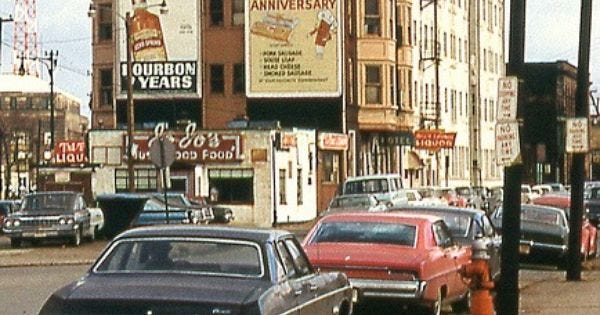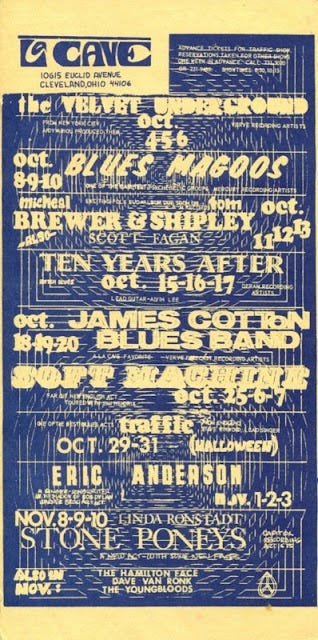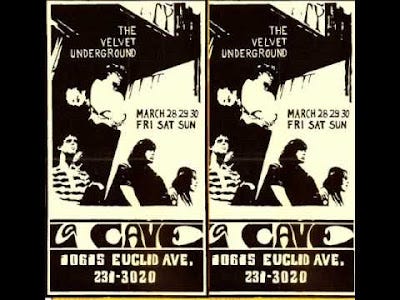[This is another article in remembrance of Cleveland’s counter-culture days and also was originally written for The New Carroll Quarterly. Since the quarterly went out of business, probably because I wrote for it, i am now free to afflict my own readers. There have been some minor changes to the original to make it appropriate to this medium.]
Cleveland during the 1960’s knew a time of political innovation [Carl Stokes was, in 1968, the first African-American elected mayor of a major American city], an active and inquiring media [two daily newspapers], compelling and tragic sports seasons, and the greatest collection of characters ever to grace the urban landscape.
It has always been a city of paradox and extremes.
As a native, it is Cleveland's role in music for which I'm particularly grateful. While it is the host city for the Rock and Roll Hall of Fame, what may be missed by those not native is the role the small clubs and gathering places had in supporting the nascent artistic community that became the massive rock music industry.
It was in these small clubs that we heard many of the most talented representatives of the cultural explosion that began in the ‘60’s. Whether it was a small jazz club on West 25th where Miles Davis performed not ten feet away from the beer stained tables, a dingy rock house on East 24th that saw David Bowie’s first American performance, or the restored 200-seat theater in Playhouse Square that presented Bruce Springsteen in concert for $5, it was the creativity and expansiveness of Cleveland’s venue owners that launched a sound, a vibration, that still echoes.
Now, Euclid Avenue is one of the least prepossessing streets anywhere in the United States. In the downtown of Cleveland the avenue has some older, urban charm, but after ten blocks or so it surrenders to a collection of auto body shops, liquor stores, cinder block apartment buildings, the Episcopal cathedral, and, in the early 1960's on East 106th Street, one struggling pool hall that eventually surrendered to its fate.
It was then purchased, in 1962, by a couple of enterprising fellows who wanted to start a coffeehouse like those in New York City. They gave it the name La Cave [pronounced in the American, rather than French, manner], mainly because the locale was at the bottom of a long, steep, narrow, and dark stairway in the building’s basement.
Eventually, they began to offer not just coffee. The new owners invited local and transient musicians to perform in the corner of the club, and that's when history was made.
During its seven year lifespan, La Cave, that dingy basement club on that dull avenue, hosted performances by Simon & Garfunkel, Jose Feliciano, Ian and Sylvia, Phil Ochs, Janis Ian, Richie Havens, Arlo Guthrie, and Judy Collins.
As folk music surrendered to rock music, La Cave changed its program and introduced Cleveland to early performances by Jimi Hendrix, Jefferson Airplane, the Youngbloods, the Butterfield Blues Band, the Jeff Beck Group [with Rod Stewart], Canned Heat, Iron Butterfly, and The Stone Poneys [with their teenage vocalist, Linda Ronstadt].
However, what became the biggest act in Cleveland, and the most familiar returning act at La Cave, was Greenwich Village's own The Velvet Underground, featuring Lou Reed, widely known as Andy Warhol's favorite band.
Not bad for an underground room that could, at best, hold a couple of hundred people in an uncomfortable closeness, filled as it was with motley tables and chairs purchased from the cathedral's rummage sale.
All good things, however…. As rock music became a massive, multi-billion dollar industry whose musicians could fill stadiums, the role of little clubs such as La Cave would subside and, as early as 1969, it would close for good.
I hope that the owners took heart, especially in reflection, at how they changed the world's music simply by indulging in an off-center idea for entertainment and opening those doors. It was a glorious leap of faith, wasn’t it?
This may be why, when the world is too much with me, I can find solace in a dark place listening to an artist, his or her songs, and the simple chords of their instrument. Behind that simplicity is a wondrous, comforting depth and well-rooted familiarity.
Robert Clements is a philosopher and Episcopalian minister in Connecticut. He grew up in Euclid and was a graduate student at John Carrol University. Like many of our readers and writers, he worked at Higbee’s Department Store.
For Coracle readers: Here, have some fun.




World's first music video? Cool.
This just confirms I was born in the wrong decade. 😜